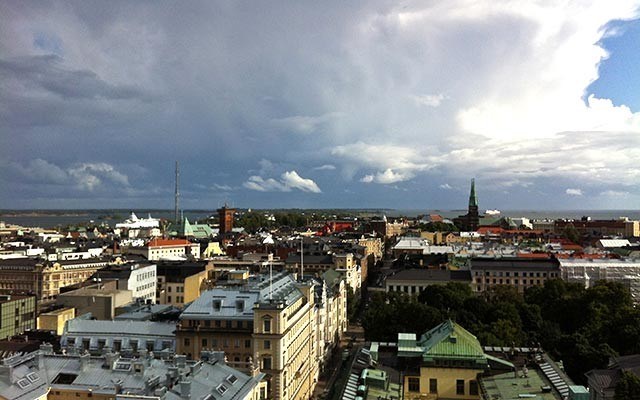No one was more surprised than the Finns — languishing in the shadow cast by the rest of Scandinavia — when post-millennium travel guides quietly began to tire of Stockholm's hyper-hipster culture in favour of declaring the Finnish capital the new "it" place. The advent came with good reason. Built around an archipelago and convoluted set of embayments on the Baltic Sea, Helsinki is graced by superb architecture and urban spaces, many parks, lakes, a ton of art and design, wild nightlife, and interesting food. All discovered quickly enough when walking around this cutting-edge city that is, in many ways, a pedestrian's delight.
To start, the city's brief (relative to the rest of Europe) 450-year history means that divining influences requires only the briefest of historical sketches. Although it is these days simply western Europe's northernmost country, Finland was part of Sweden from 1155 – 1809, at which point it became a Grand Duchy of the Russian Empire. The country's eventual independence, gained in 1917, instilled a huge sense of national pride. It was this honour which, during the Second World War, motivated Finns to fight off invasion attempts by both Germany and the Soviet Union. Official languages remain Finnish (a sui generis with no known linguistic peer) and Swedish (though most Finns speak better English than Swedish).
With a vast network of ski, skate, hike and cycle trails that Whistlerites could well relate to, there's plenty to see and do in Helsinki at anytime, but summer offers an entirely different dimension. With the darkness of winter in such a northerly locality mirroring their national character of reserve and quietude, Finns seem to save up their considerable energies for summer's 24-hour daylight and what seems a parade of never-ending festivals and goings-on. Top of the list is the annual Helsinki Festival, Finland's biggest multi-arts event that fills two weeks with classical and world music, circus, dance, theatre, art, and film. The new KoeHelsinki ("Experience Helsinki") festival park and Kansalaistori ("Citizens' Square") at the heart of the festival offer a place where you can satisfy a hunger for culture and arts, as well as a range of food items. International and eclectic in scope, the program at the Huvila Festival Tent this year includes legendary band Los Lobos as well as Ginger Baker, the enigmatic drummer of Cream fame and subject of the documentary Beware of Mr. Baker.
Despite the abundant music while I was there, I found myself gravitating to art openings, most of which were free. First up was a "Tove 100" centenary event to mark the 100th anniversary of the birth of treasured writer/artist Tove Jansson (1914-2001). Jansson's multifaceted work and immense international success made her one of Finland's key visual artists during the post-war golden age of modernism — most widely known for creating the Moomins, beloved, adventurous, and subtley moralizing cartoon creatures that have been the subject of books, movies and even a theme park. Of deeper interest was an exhibition on the work of Hilma af Klint, a celebrated mainstream artist who began painting abstracts in the early 1900s but stipulated they could not be shown until 20 years after her death. Strolling the gallery of experimental works on controversial themes like feminism, zen spirituality, and evolution was fascinating, making it clear she was not only ahead of her time, but knew it. My favourite event, however, was the Finnish Museum of Photography exhibition, #snapshot, which expertly updated the global snapshot concept around the premise that never before have ordinary people generated such a wealth of photographs, nor had the ability to share them with such wide audiences. Consisting primarily of photographs taken by ordinary people sourced from the Internet, the exhibit also offered a history of the selfie and new works by international artists commenting on the phenomenon, in part carried out through interactive experiences both on-site and online, in which visitors' own images were incorporated in real time.
A walk around the city's Design District is in order no matter the time of year but particularly during Helsinki Design Week, the biggest such event in Northern Europe (this year's10th anniversary is Sept. 4 – 14). Tailored walking routes offer design enthusiasts a range of interesting themes. "New Living Room," for instance, is like a sort of outdoor IKEA stroll. Whether you're into retro or modern or something in between, the focus is on Finnish and Scandinavian design with a hint of India in the mix, including both furniture and smaller items for the home. The route ends at Klaus K, the first design hotel in Finland (a fun look on its own). Other routes include the ecologically oriented "Sustainable Design Shopping and Local Food," and the "Classics are Forever," which includes stops at Marimekko, Iittala and Artek — the most famous names in Finnish design — as well as up-and-coming designers. A good place to end a Design District walk is Hotel Torni (Hotel Tower), an historical hotel which, when first opened in 1931 was Finland's tallest building, and remained the loftiest edifice in Helsinki until 1987. The tower served the needs of air defence during WWII, from where the Finnish women's paramilitary organization Lotta Svärd kept watch for enemy bombers. Immediately after the war ,the hotel served as headquarters for the Allied Control Commission, monitoring Finnish compliance with the obligations of the Moscow Armistice. Later, it became a centre of culinary excellence and it still maintains several restaurants, including the top-of-tower Ateljee Bar known for its changing exhibitions of Finnish artists and, especially, its toilets, whose scenic glass walls to the outside deliver views over downtown Helsinki and the Baltic port.
What better way to find a city than to trace your route through it on high from the best seat in the house?
Leslie Anthony is a Whistler-based author, editor, biologist and bon vivant who have never met a mountain he didn't like.




